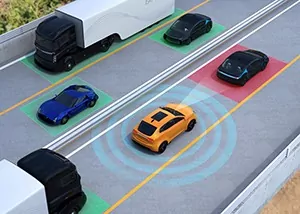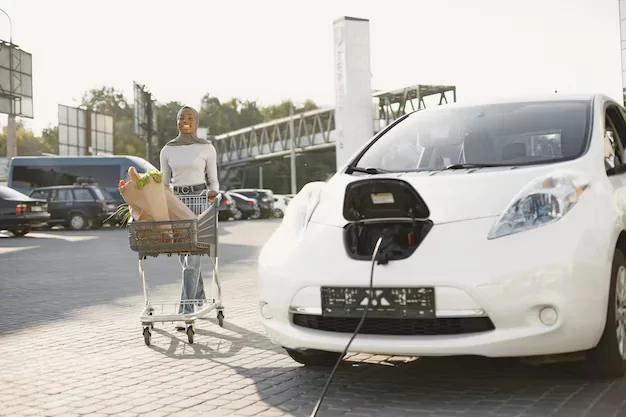In the rapidly evolving landscape of automotive technology, the rise of autonomous vehicles (AVs) is on the horizon, promising to revolutionize how we commute and travel.
The automotive industry is gearing up for this highly skilled digital chauffeur that is navigating the roads with expert precision while the drivers rests.
And with the arrival of self-driving cars comes the need for meticulous foresight and an unyielding focus on user experience in order to provide the convenience it is meant to.
It’s important to understand that the journey ahead is paved with strategic decisions, technological breakthroughs, and a constant focus on making the ride smooth, and efficient for everyone.
Dealerships are essential to the process of adopting and adjusting to this new era as it develops.
Technology integration, customer-centric planning, and strategic planning are all necessary to get your dealership ready for autonomous vehicles.
In this blog, we will dive deep into understanding how you can prepare your dealerships for autonomous vehicles. Let’s read on.

Understanding How You Can Prepare Your Dealerships for Autonomous Vehicles
Here are a few tips to begin your dealership’s transition into the era of autonomous vehicles:
1. Embrace Autonomous Technology
Although fully autonomous vehicles might not hit dealership lots immediately, various factors are involved in its popularity. The automotive industry is taking a thrilling leap into the future, embracing autonomous technologies that promise to redefine how we experience transportation.
This journey unfolds like a story, each page showcasing advancements that bring us closer to vehicles capable of driving themselves.
Let’s map the terrain:
- Levels of Autonomy: From hands-on driving (Level 0) to fully autonomous vehicles (Level 5), understanding this spectrum is key. Features like self-parking, lane assist, and emergency braking are just the first chapters, laying the groundwork for future marvels.
- Safety First: Collaboration between manufacturers and regulators is crucial to ensure these cars don’t just move, but move safely. Passengers, pedestrians, and everyone in between deserves the utmost protection.
- Building Trust: Widespread acceptance hinges on educating consumers about both the benefits and limitations of autonomous vehicles. We need to be transparent about what these cars can and cannot do, building trust one mile at a time.
- The Connected Ecosystem: Data processing, connectivity, and smart infrastructure are the fuel that powers this revolution. V2I communication (vehicle-to-infrastructure) will be the language of the road, enabling seamless collaboration between cars and their environment.
- Shifting Landscapes: This technological transformation will reshape industries and employment patterns. We need to prepare for the wave and navigate the changes thoughtfully.
- Ethical Crossroads: Cybersecurity, decision-making algorithms, and coexistence with traditional cars pose ethical challenges that demand careful consideration. We must steer clear of pitfalls and navigate this uncharted territory with responsibility.
- Continuous Innovation: Research and development remain the engine driving progress. Enhancing capabilities, safety, and real-world implementation require an unwavering commitment to pushing the boundaries of what’s possible.
Continuous training on emerging autonomous technologies will be key, as advancements in technology will introduce more autonomous features in future vehicle models.
2. Enhance Consumer Experience
The traditional product-centric sales model in many dealerships needs to shift towards a consumer-centric approach. Today’s consumers are well-informed before stepping into a showroom and expect a seamless, efficient, and convenient experience.
Incorporate mobile technology during sales and F&I processes, understand and adapt to customers’ needs as they arrive, and consistently integrate new technologies into the dealership experience.
For instance, consider implementing online scheduling for test drives and service, using text and email for instant confirmation, and exploring virtual reality for immersive vehicle experiences.
3. Focus on Used Cars
The impact of autonomous vehicles is expected to be most significant in the new car sector, particularly when cities adopt autonomous ride-sharing models. However, a considerable number of individuals will still prefer driving, distrust self-driving cars, or reside in rural areas where personal vehicles are necessary.
Used cars with level 3 and 4 automation features are projected to gain popularity. These vehicles cater to a broader audience, providing a gradual introduction to autonomous features while also allowing for aftermarket upgrades.
They suit diverse driving preferences and remain essential in areas without access to ride-sharing services. Moreover, they act as a stepping stone for owners to experience advanced tech before transitioning to newer models.
Overall, these used cars represent an intriguing segment in the automotive market, combining accessibility, adaptability, and a bridge to future advancements in autonomous vehicles.
Moreover, they’ll enable owners to upgrade to newer technology-equipped vehicles more swiftly.
4. Understanding the Shift
According to forecasts by industry experts, the autonomous vehicle market is projected to reach substantial figures.
By 2030, it’s estimated that the global autonomous vehicle market will surpass $500 billion, with a significant portion attributed to the sale and servicing of AVs in dealership networks.
Advancements in technology, such as AI and sensors, are enhancing safety and efficiency, boosting consumer trust. Significant investments from various sectors are accelerating innovation, while regulatory developments are shaping clearer deployment guidelines.
Increasing consumer demand for safer and more convenient transportation, alongside the potential for fleet and mobility services, further drives market growth.
Additionally, economic benefits, environmental sustainability, and collaborative partnerships among industry players are propelling the autonomous vehicle market expansion.
Understanding this multifaceted landscape illuminates how these factors collectively contribute to the projected market boom.
5. Adapting Sales Strategies
Dealerships need to align their sales strategies with the changing consumer demands. Potential buyers of autonomous vehicles will prioritize different features compared to traditional vehicles.
For instance, safety, connectivity, and the quality of onboard technology will be paramount.
A seamless transition involves training sales teams to educate customers about the benefits and functionalities of AVs.
| Consumer Priorities | Percentage of Respondents |
| Safety features | 45% |
| Connectivity options | 30% |
| Quality of onboard technology | 25% |
Source: Autonomous Vehicle Consumer Survey
6. Service and Maintenance
The service landscape will also witness a significant transformation. AVs will require specialized maintenance and repair due to their complex technology. Dealerships should invest in training technicians to handle autonomous vehicle diagnostics and repairs effectively. According to industry estimates, the demand for skilled technicians in AV servicing will increase by 35% in the next decade.
| Technician Skills Needed | Expected Demand Increase |
| Autonomous vehicle diagnostics | 35% |
| Software integration and updates | 40% |
| Sensor calibration and maintenance | 30% |
Source: Automotive Technician Labor Market Study
7. Infrastructure Upgrades
To conquer the coming wave of autonomous vehicles, dealerships must undergo a deep-dive transformation.
This journey involves three key infrastructure upgrades:
- Powering Up for the Electric Future: Installing charging stations for electric AVs ensures they won’t run out of juice.
- Gearing Up for the Tech Revolution: Creating specialized service areas and robust connectivity allows technicians to handle software updates, sensor calibration, and other AV-specific needs.
- Bridging the Knowledge Gap: Remodeled showrooms become education hubs, where staff trained on AV features guide customers through this thrilling new landscape.
These upgrades are more than just bricks and mortar; they’re a vote of confidence in the autonomous future. By embracing these changes, dealerships will be ready to market, service, and support AVs, paving the way for a seamless and trust-filled experience for their customers.
8. Customer Experience
Enhancing the customer experience will be crucial in this transition. The customer experience during the transition to autonomous vehicles involves:
- Personalized demonstrations during test drives to showcase real-time autonomous features’ benefits.
- Implementing immersive VR/AR experiences in showrooms for interactive learning.
- Hosting educational workshops explaining how AVs work and their safety aspects.
- Simplifying complex technology through user-friendly interfaces and clear explanations.
- Providing comprehensive educational materials and FAQs about AVs.
- Training staff to address customer queries effectively and knowledgeably.
- Collecting feedback for continuous improvement in customer service.
- Offering post-purchase support and educational resources for maximizing AV benefits.
By focusing on these strategies, dealerships can create an engaging and informative environment, aiding customers in understanding and embracing autonomous vehicle technology.
What Does the Autonomous Future Mean for Your Dealership?
The unmistakable emergence of autonomous vehicles looms on the horizon, even as the precise timeline for their arrival remains uncertain.
However, one undeniable reality stands out: the automotive retail sector must swiftly adapt to remain at the forefront of this evolving landscape.
To ensure your dealership maintains a leading position amidst the transformative impact of self-driving cars, immediate action is imperative to prepare comprehensively.
Starting to prepare for these changes now is essential if you want to ensure your dealership stays competitive and well-positioned for the future. This proactive stance necessitates more than mere observation or retrospection.
For this, a forward-thinking approach is required, encompassing anticipation of impending changes, strategic planning to seize new opportunities, and meticulous refinement of the customer experience. This is essential to seamlessly accommodate the forthcoming revolution in automotive technology.
The Bottom Line
The era of autonomous vehicles presents both challenges and opportunities for dealerships.
By proactively adapting sales strategies, investing in technician training, upgrading infrastructure, and focusing on customer experience, dealerships can position themselves at the forefront of this transformative shift in the automotive industry.
Preparing for AVs is not a one-time endeavor, but an ongoing process of adaptation and evolution.
By focusing on these key areas, dealerships can not only weather the coming changes but also emerge as leaders in the exciting future of personalized mobility.
With Autosoft, embracing change and being prepared for the future of autonomous vehicles is not just a necessity but an opportunity for dealerships to thrive in the evolving automotive landscape.
Explore more resources
How AI & Big Data is Shaping the Future of Automotive Retail
In this blog, we’ll explore how data and AI are reshaping the automotive retail industry, from manufacturing to the driving…
The Art of Auto Dealership Marketing: 8 Strategies for Success
In today’s fast-paced and competitive automotive market, mastering the art of car dealership marketing is essential for staying ahead of…
One Family’s Journey in Automotive
Black History Month is a powerful reminder to all Americans and the world of our undeniable impact on this country….
Stay up to date
Subscribe to get the latest auto industry insights from Autosoft experts






